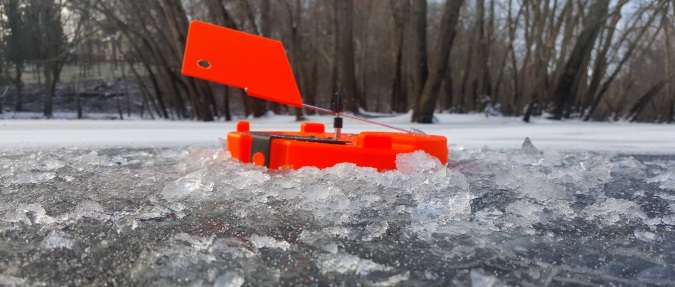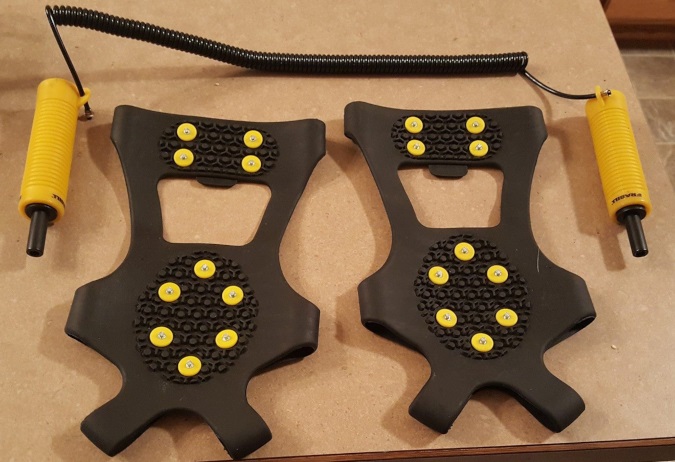
Your alarm clock goes off and it is Monday morning again. You slide out of bead, throw on some slippers and stumble down to the coffee pot to pour you a cup of joe and step outside to see what the morning is like before heading off to work. As you take your first sip you notice there is something different about this morning from previous mornings. There is a stronger nip at your nose, the breeze is cutting through your hoodie a little more and there is a sense of stillness around you. Instantly you know….it is almost that time. First ice is just around the corner!
It is hard to measure the excitement of ice anglers as they prepare to venture back onto the frozen sheets of opportunity they left behind last spring. Some say to themselves, “This will be the year I finally catch that monster that lurks in the deep” or “This year I know I can beat my personal best”. For some it is a chance to spend more time with their families in the outdoors, teaching their kids how to tie jigs on and read sonars. The passion for ice fishing that anglers have is hard to rival with most things. It is definitely something special that only people who live in the ice belt will understand.
Now something that we MUST remember though all the excitement and anticipation is that first ice is not only magical but can be very dangerous. Safety is often overlooked and ignored in order to get to that one spot or to be able to say “I was the first one out” but none of that matters if you’re at the bottom of the lake. No one wants to get that phone call from the sheriff’s department saying “You’re not coming home”. Even if one person falls through and doesn’t survive throughout the whole season it is too many. We have to keep each other accountable and safe. We must make it home to our loved ones after each outing. We must take first ice safety seriously. Here is a list of items from various companies that have been developed to help keep you safe on first ice along with some practical tips to keep in mind when making that fist excursion on the lake.
First we will start with easy tips to remember. These are things to remind yourself and others and also good things to keep doing throughout the whole season as ice is ever changing and even in late February you can still stumble upon cracks, holes, and weak spots when there is a solid 38” of ice on the lakes.
Things to remember;
- Tell your spouse, neighbor, or even a friend what lake you are headed to and a rough estimate as to when you will return. This insures that if you’re not home within a reasonable time someone notices and can point authorities in your direction. This also applies if you change lakes throughout the day.
- Bring another person with. Do not go out alone. It is easier to get out of the water if there is someone to help you or call for first responders if you fall through.
- Check with local authorities and/or DNR about current ice conditions on the lakes you plan to visit that day. They may have already responded to an emergency on that particular body of water and can save you the risk of going through.
 These key things can save you and you’re loved ones a lot of issues without spending a penny. Next we will take a look at some products that were designed to help keep you safer on the ice.
These key things can save you and you’re loved ones a lot of issues without spending a penny. Next we will take a look at some products that were designed to help keep you safer on the ice.
Products;
- Ice picks and ice cleats. There are several companies who make these items and both are relatively cheap. The ice picks look like to bicycle handles strung together by rope or a plastic coil. Inside the handles are a single retractable carbide spike that when pressed against the ice protrude out and allow an angler to climb out of the water after he or she has fallen in. Ice cleats are a rubber or chain slip on for your boots that have either chains like a tire chain or carbide spikes on the underside to help you walk and keep from slipping on ice. Since first ice is usually bare and slick, both these items are excellent things to keep you standing upright on the lake. These two tools I personally carry with me all season long. They are light and easily stored. A few companies that make and sell them are Frabill, Clam Outdoors, HT Enterprises, and Rapala.
- Spud bar. A spud bar is a very useful tool for early ice. It is a long bar with a hole and loop of string on one end and on the other is a spike or chisel. As you walk onto the lake you use the spud bar to check for weak or thin ice. Every few steps stab with spud bar into the ice a foot or so ahead of you with some mild authority. The rule of thumb is that if the bar goes in so will you. Now this is not a fool proof technique as we all have different strengths and weights. This is more of a guide for keeping off unstable ice in general. Always use extreme caution. A few companies that make spud bars are Eskimo, Cabela’s, Jiffy, and Clam Outdoors.
- Life jackets or PDFs. Life jackets and PDFs are not just for open water. Wearing a life jacket or coast guard approved PDF while on first ice and be just as effective at saving your life as in a boat.
- Floatation suits. There are a few companies who manufacture winter suits that also double as float suits. Now these are NOT coast guard approved PDFs and are not to be used like one but they do have the ability to keep one afloat in the water for some time. More and more anglers across the ice belt are using float suits as added safety on the ice. I myself have one and wouldn’t trade it for anything. Warm, durable, comfy, and it floats. The main companies who sell float suits are Clam Outdoors, Striker Ice, Frabill, and Eskimo.
There are many other ways to keep safe on first ice but the most important thing to remember is that ice is never safe. It is constantly changing, shifting, breaking etc. Always use caution, tell family where you are headed and when you will be home. Bring ice picks and a life jacket. Stay away from dark spots or cloudy spots as they are most likely weak. And remember no fish is worth your life.
With all that being said, first ice is almost upon us and the itch is getting more noticeable. Soon it will be go time. Don’t forget to re-spool your reels and check your augers for needed repairs. Charge you sonar batteries and dust off your ice houses. Good luck out there and stay safe!
Kyle Lynn
